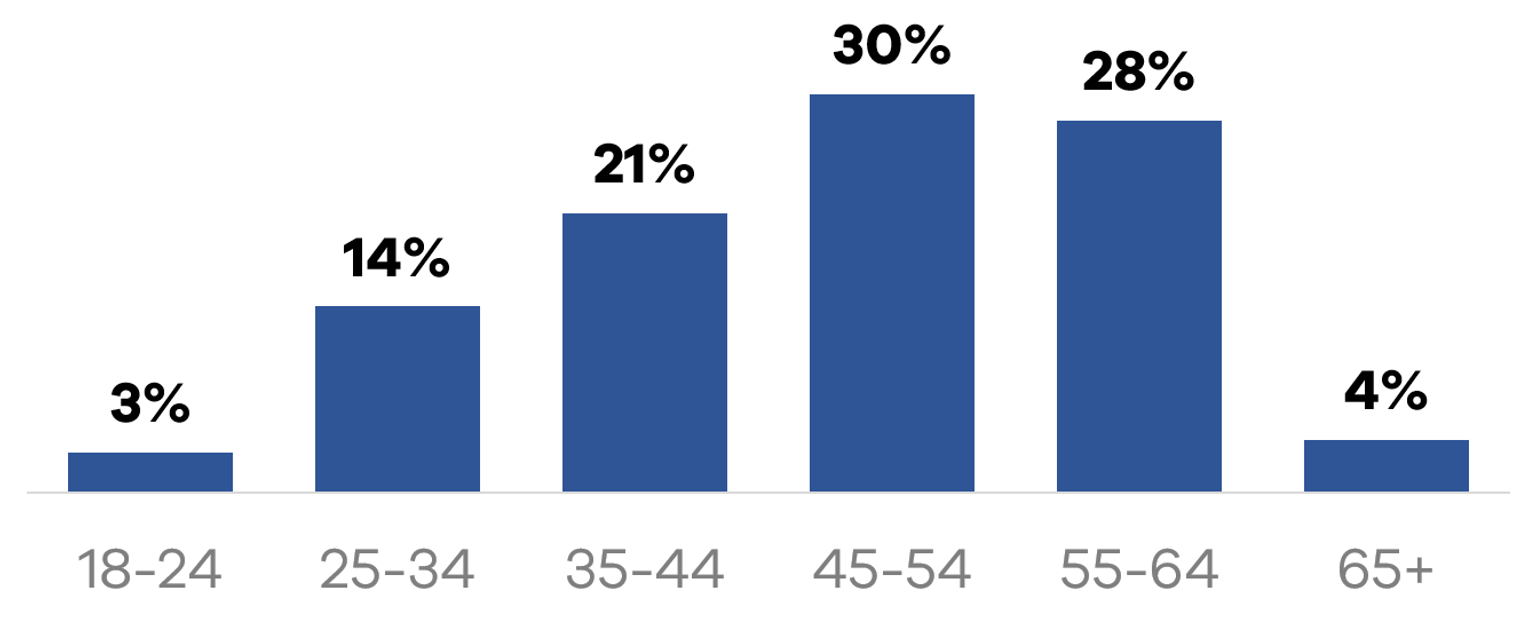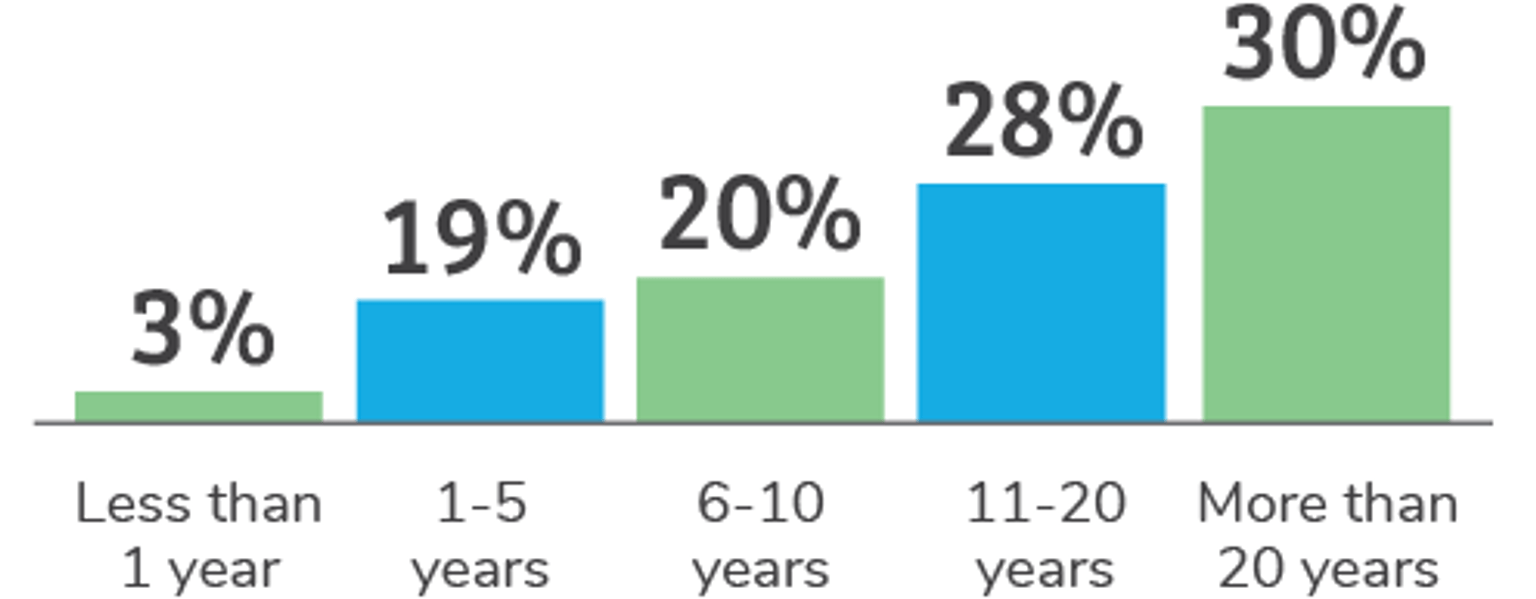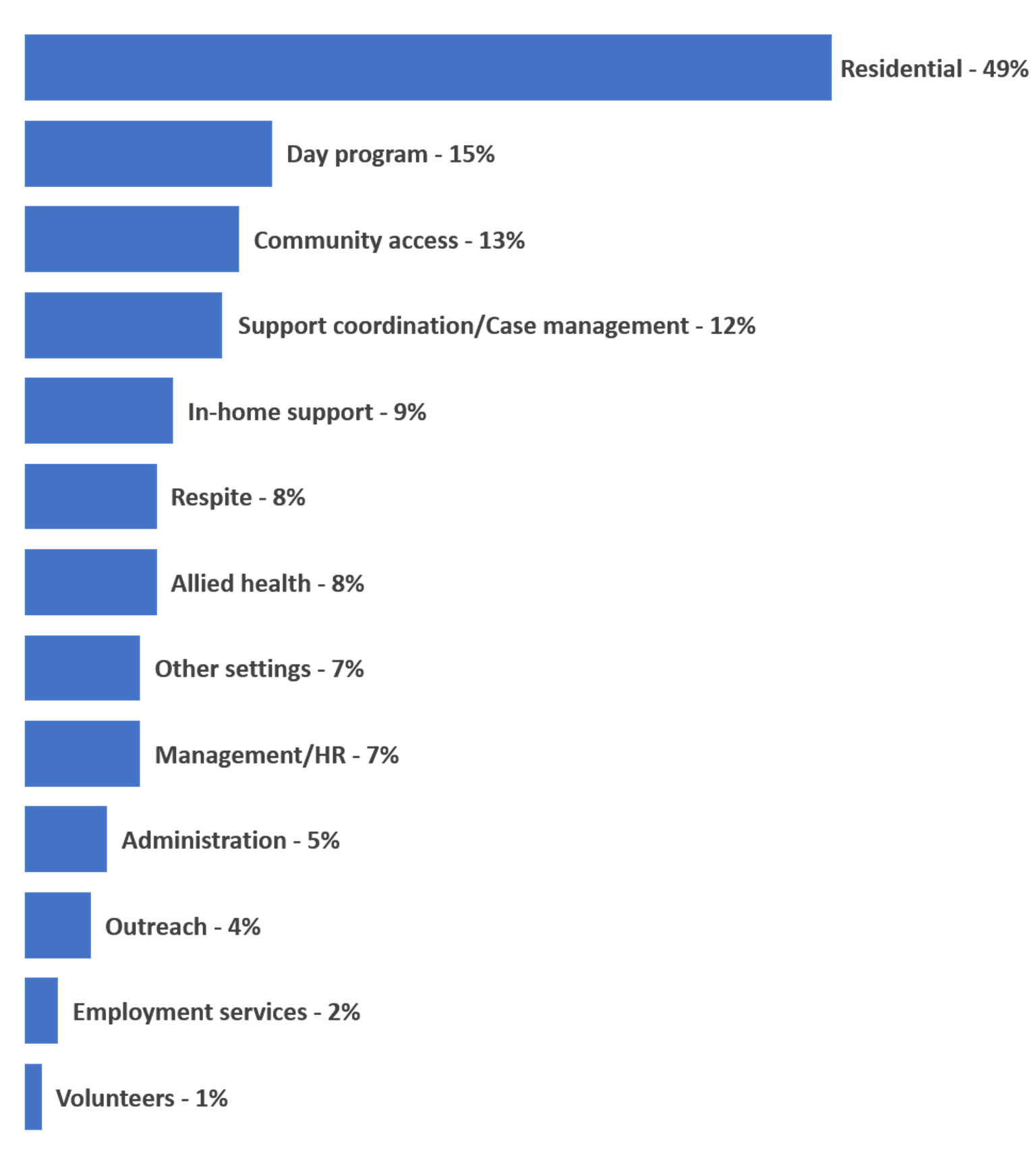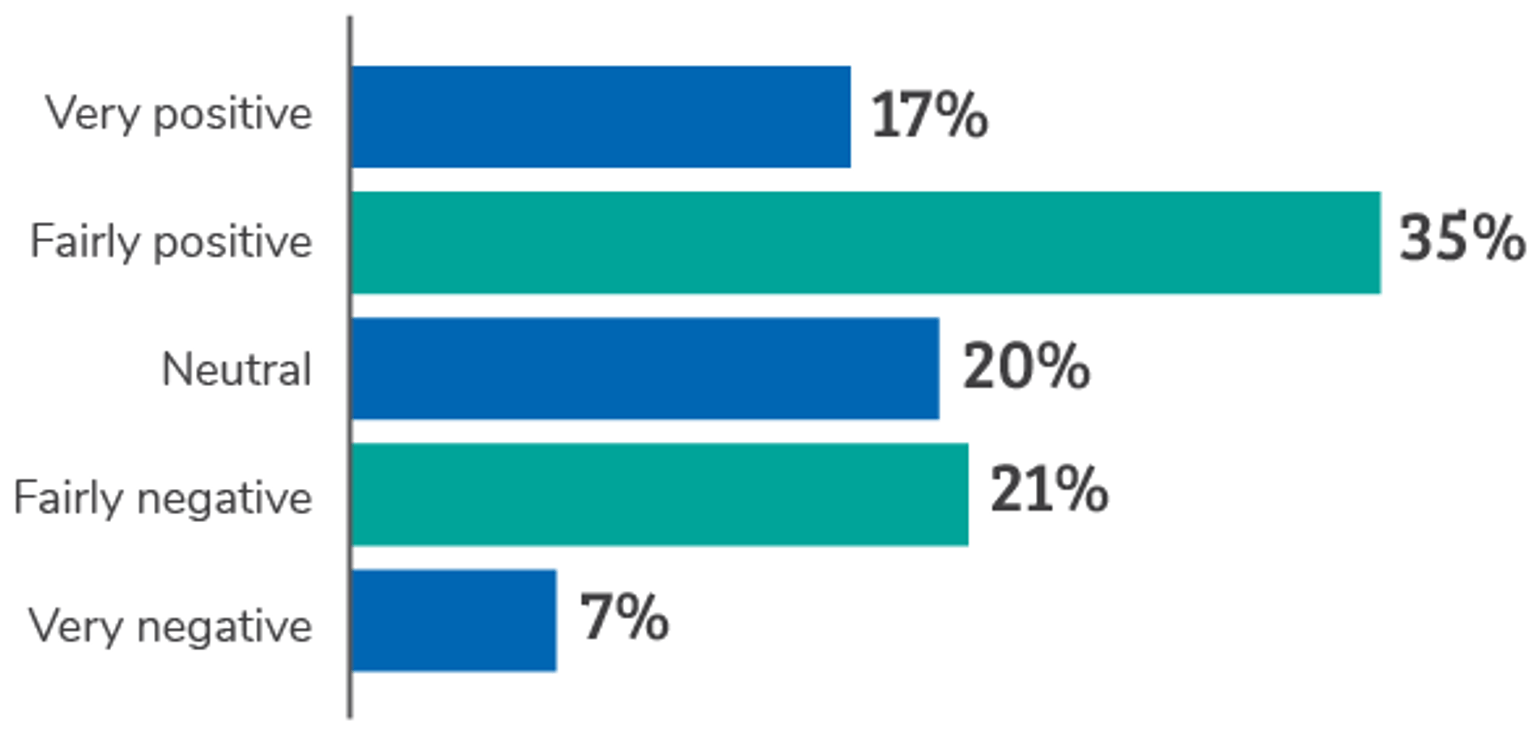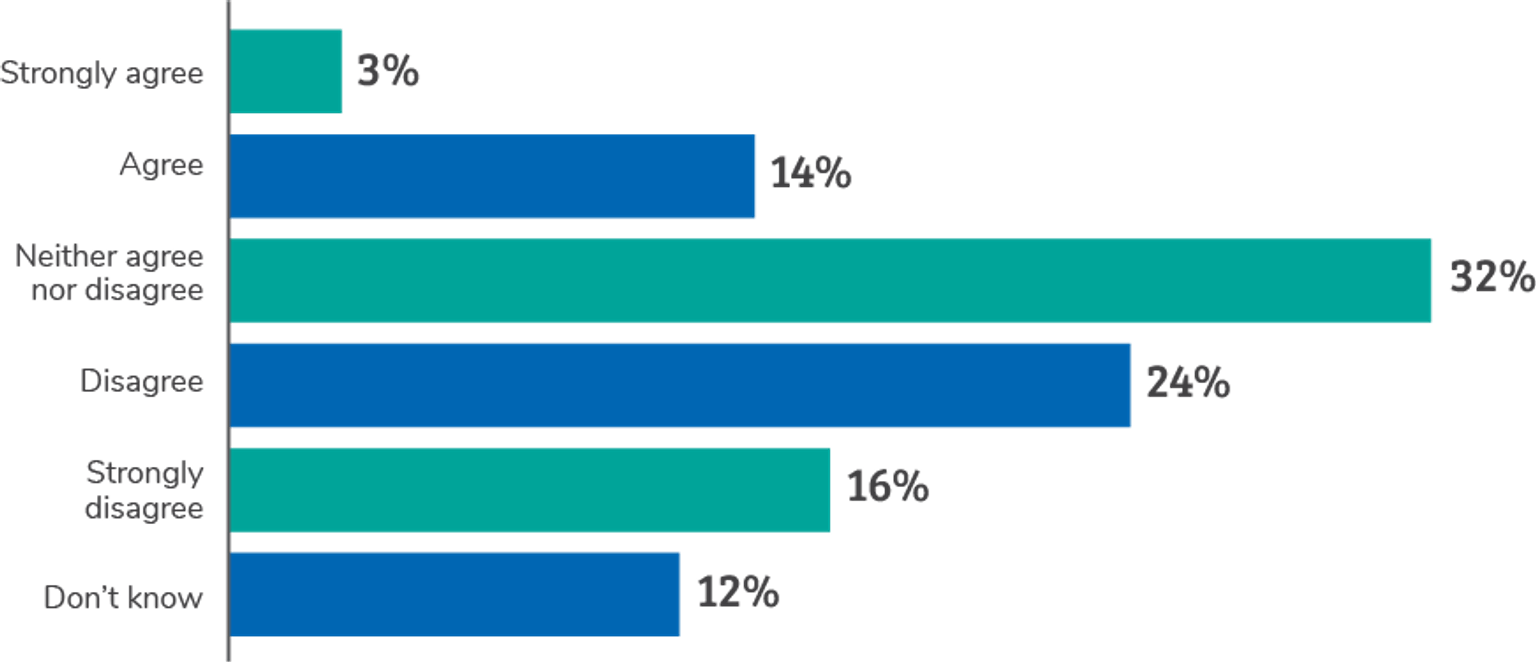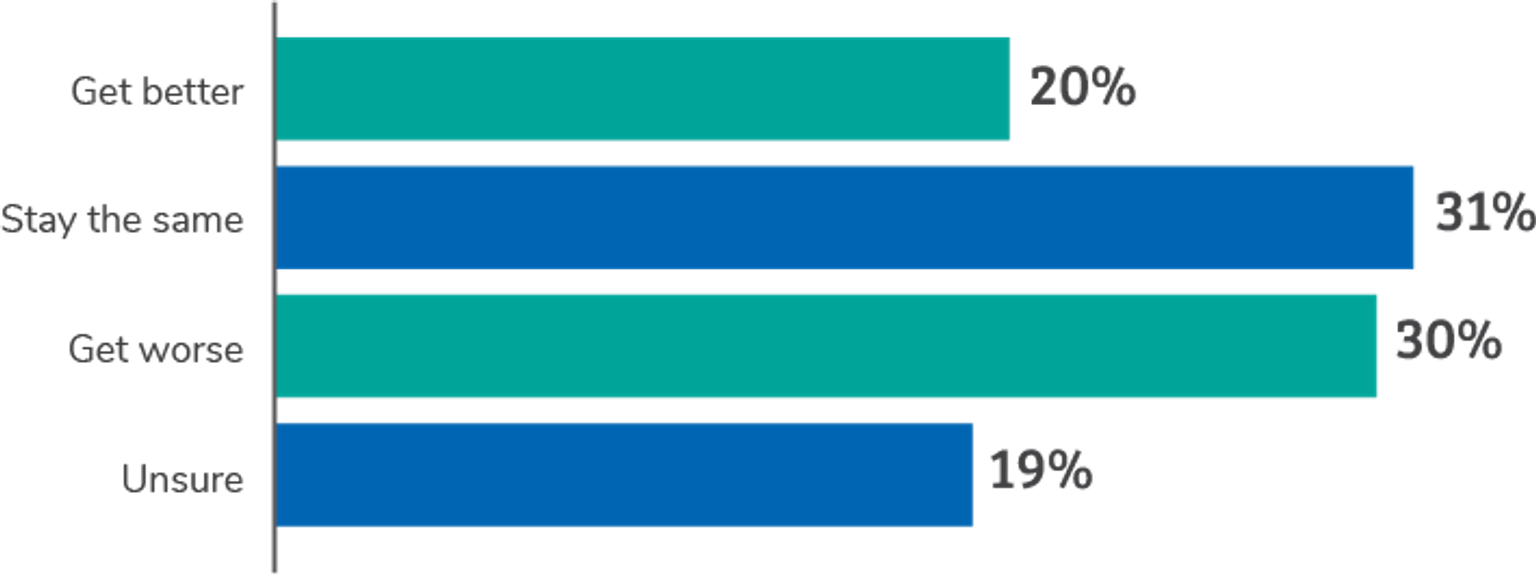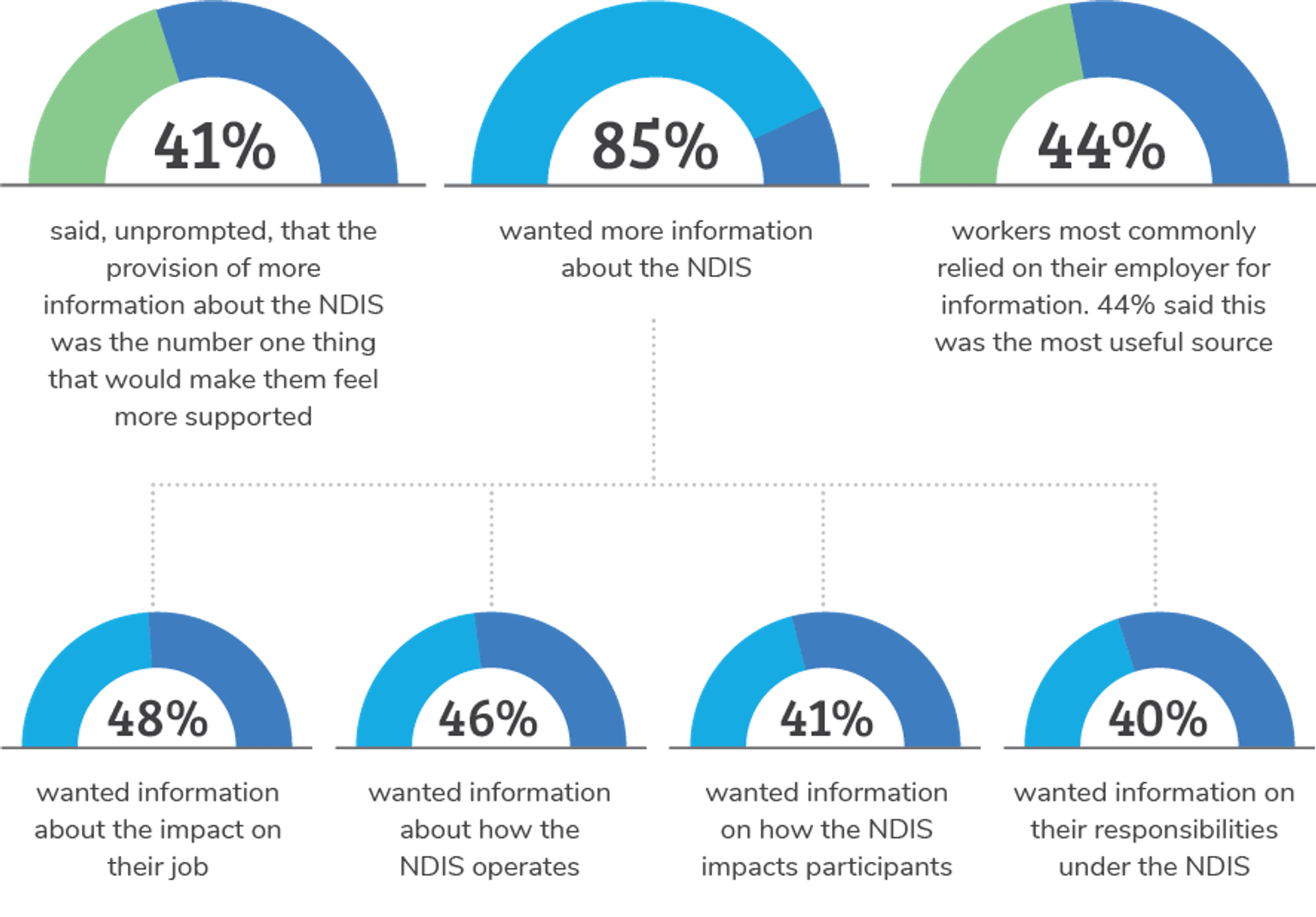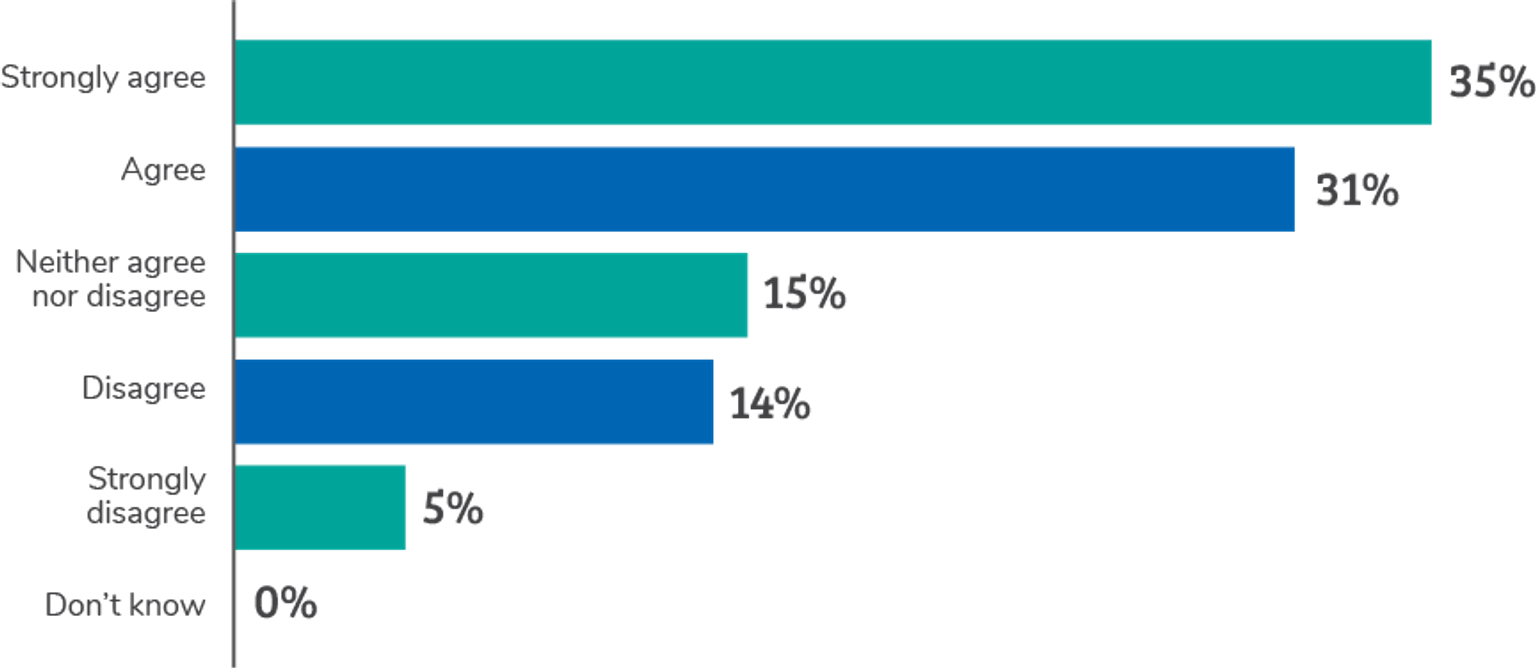- Published by:
- Department of Premier and Cabinet
- Date:
- 31 Oct 2018
Understanding the workforce experience of the NDIS: longitudinal research project is a 3-year study that aims to build an understanding of the disability workforce’s experience of the National Disability Insurance Scheme (NDIS).
Specifically, the research aims to understand the workforce’s perceptions of the NDIS and experience of transition, how the NDIS is impacting their work, and the skills and training the workforce needs under the NDIS. This will help the Victorian government better support the workforce during this time of unprecedented change.
This research forms a key component of Keeping our sector strong - Victoria’s Workforce Plan for the NDIS (the Plan) and more specifically Priority 1 – Understanding Workforce Needs. This report presents highlights and recommendations from the first of three years of longitudinal research. The results highlight both the challenges faced by the workforce in transitioning to the new scheme, and a range of opportunities to better support the workforce.
The research was commissioned by the Victorian Department of Premier and Cabinet1 and conducted by Ipsos Public Affairs, an independent research consultancy. Research has been guided by an Expert Advisory Panel, including representation from:
- The Health and Community Services Union (HACSU)
- VCOSS-RMIT Future Social Service Institute
- National Disability Services
- Mental Health Victoria
- Carer Solutions Australia
- The Department of Education and Training NDIS Reform Division
- The Department of Health and Human Services NDIS Workforce Management and Readiness Division
- The Department of Premier and Cabinet NDIS Branch, who commissioned this project
Footnote
1 The Workforce Design team is now positioned within the Disability and Communities Branch of the Department of Families, Fairness and Housing (DFFH). For the remainder of the report DFFH will be referenced where relevant.
Why did we conduct the research?
Outlines why we need to understand the experiences of disability workers over time.
In March 2013, legislation was passed in Australia to establish the NDIS, which aims to provide Australians with a permanent disability the ‘reasonable and necessary supports they need to live an ordinary life.’ The scheme involves a new way of funding disability services: rather than funding being directed to disability support providers, it is provided directly to people with disability (NDIS participants). Participants select who will provide their supports and services and can negotiate how these are delivered. This gives people with disability more choice and control managing their disability supports.
In Victoria, the NDIS is rolling out to different regions in stages, beginning in 2013 and ending in 2019. The NDIS means a big change for participants, but also for people working in the disability sector. In some areas in Victoria there is a need to almost double the disability workforce to meet the needs of participants. The NDIS also demands new skills and new ways of working and it may affect the structure of the workforce and employment arrangements.
While some research has already been done about the workforce’s experiences of the NDIS in pockets of the sector, there was a need for research across Victoria on how the workforce in all disability settings and regions are experiencing the rollout over time. Improving the understanding of these issues will mean that the Victorian Government, the National Disability Insurance Agency and disability service providers are able to support the existing workforce during this time of unprecedented change. It will also help the Victorian Government build a workforce that is skilled, diverse and delivers high-quality, innovative support to achieve the best possible outcomes for people with disability.
How did we conduct the research?
Explains what method and types of questions we used to gather information for the NDIS workforce longitudinal research study in 2018.
The methodology and questions used in this research were designed in collaboration with experts from the sector: disability workers, service providers, the Health and Community Services Union, peak bodies and government. Together, it was agreed that a survey was needed to measure the impact of the NDIS on the workforce over time, followed by qualitative research to understand the experiences of workers in greater depth.
Workers were invited to participate in the research through disability networks, by direct contact with disability providers, and through an advertisement on the Victorian Government website. Workers registered for the survey and then completed it online via an email invitation. The survey involved a range of closed and open-ended questions and gave workers the option to register their interest to participate in future qualitative research.
The focus groups and in-depth interviews were more open-ended in nature, allowing workers to describe their experience in their own words. Throughout this report, findings from the survey are presented as statistics, and findings from focus groups and in-depth interviews are presented as summaries of workers’ words, and in direct quotes from workers.
779 workers participated in the survey, 37 workers participated in one of six focus groups held in different parts of Melbourne, and 55 workers from across the state participated in an in-depth interview between March and June 2018.
Who took part in the research?
Information about the disability workers who took part in the NDIS workforce longitudinal research study in 2018.
An effort was made to recruit people from all disability settings and across Victoria.
Survey participants were most commonly aged 45-54, located in metropolitan Victoria and had worked in the sector for over 20 years.
They were most commonly employed full time, worked in the public sector and were working in a region that was rolled out under the NDIS.
Almost half worked in a residential setting, and over half were members of the Health and Community Services Union. The characteristics of participants reflects the fact that the survey was advertised through the networks of the Expert Advisory Group. In future years, further strategies will be used to encourage a more diverse range of workers to participate. The characteristics of survey participants are outlined overleaf.
The demographic breakdown of the respondents taking part in the research included:
Gender
- 73% of respondents undertaking the research were female
- 26% of respondents were male
Location
- 64% of respondents worked/lived in metropolitan locations
- 37% were in regional locations
Indigenous status
- 1% of respondents identified themselves as Aboriginal or Torres Strait Islander
Employment status
- 84% of respondents said that they had worked for a single employer/organisation
- 13% had worked for multiple employers/organisations
- 3% said they were self-employed, directly employed by their client/s or a freelancer
Form of employment
- 45% of respondents had a permanent full-time job with paid leave entitlements
- 38% had a permanent part-time job with paid leave entitlements
- 4% had a fixed-term contract with paid leave entitlements
- 13% had a casual job without paid leave entitlements
Sector
- 40% of respondents worked for a not for profit or charitable organisation
- 5% worked in a privately owned, for profit organisation
- 55% worked for a public, government, or government owned organisation
NDIS Rollout status
- 17% had not rolled out yet
- 42% were in the middle of the NDIS roll out
- 41% were rolled out fully
Union membership
- 55% of respondents were members of the Health and Community Services Union
- 14% were members of another union
- 32% were not members of a union
What did we find?
Detailed findings from the NDIS workforce longitudinal research study in 2018.
The disability workforce are passionate about their work and their clients, and support the mission and potential of the NDIS.
However, it is a huge change for workers.
Those working under the NDIS are often finding that it is impacting many aspects of their work, while those yet to transition are often anxious and concerned about what it will mean for them. The workforce needs quality information and training to support them through this change.
This experience can be summarised into the following three opportunities and four challenges:
Opportunity: Workers are passionate about their clients.
Opportunity: There is support for the NDIS’s mission.
Opportunity: The NDIS has the potential to increase innovation and create new opportunities for workers.
Challenge: There is anxiety and uncertainty about the NDIS.
Challenge: Workers lack the information they need about the NDIS.
Challenge: Workers are concerned about the NDIS’s impact on job security and job quality.
Challenge: Workers see the NDIS as reducing time and funding for the things that matter.
Importantly, the NDIS is experienced differently by different kinds of workers in different parts of Victoria.
Opportunities
A breakdown of the opportunities identified by the study in 2018.
Opportunity: Workers are passionate about their work and want to stay in the sector
Despite the challenges faced, the workers we spoke to were very passionate about their work, particularly supporting clients to live happier, richer lives and achieve goals. The work was viewed as very rewarding, often fun, and generally very diverse.
Many participants talked about how fulfilling it can be when they feel they have made a real difference in the lives of people with disability and their families, even if it is just a ‘small thing’. The relationships developed with clients and families, sometimes over a very long period, was also critical.
While some did consider leaving the sector, most wanted to stay. For those who did want to leave, lack of career opportunity was the main reason, suggesting that there is a need to ensure progression pathways are provided to workers.
Quotes from workers who participated in focus groups or in-depth interviews demonstrate this opportunity
"If I felt I was needed and wanted then that would be nice. I love this industry. It’s definitely my priority to stay in this industry over leaving."
"You can make people’s lives better by being kind, doing little things, singing the songs, walking, giving [people] time, by not doing much you can make [people] really happy."
"I really enjoy the little things, seeing a young woman becoming more calm, more communicative. Getting a chap in the wheelchair to giggle every so often. Seeing those little lights come on."
"I’d love to get into case management or admin to get off the floor, but I don’t know what those roles look like under the NDIS… I do wish I’d had more exposure to other companies to see what it’s like working elsewhere."
Opportunity: there is an understanding of and support for the NDIS’s mission
Participants in the qualitative research generally had a very good understanding about the purpose of the NDIS in broad terms, that is, that it will increase choice and control for people with disability, enabling them to access reasonable and necessary supports to live a normal life. There was support for the need for such a system, and for the ultimate vision of the NDIS.
Comments from focus groups and in-depth interview participants
"I like to think the purpose is putting people on an even playing field to make their own decisions about their own care and support."
"Absolutely see it as being about people being able to manage their own support and be purposeful and deliberate about the support they are getting and where it is from."
"I just love it… it’s just a social revolution I support. It’s inclusive, it’s empowering to people with disability. I feel so strongly about it."
Opportunity: the NDIS has the potential to increase innovation and provide new opportunities for workers
While many workers were struggling with the changes imposed by the NDIS, some workers did share stories of opportunity. Some were working with more diverse clients or supporting clients in new ways. Others were considering beginning their own business and becoming independent NDIS providers.
The opportunity for more roles to be created within the sector was particularly important for some. Many also hoped that increased funding would mean more staff and a more balanced workload. Having funding for one-on-one support was important and meant workers could be more dedicated to their clients as individuals, rather than within a group.
Quotes from focus group and in-depth interview participants
"There’s potential with the creation for NDIS for more jobs and roles to arise, theoretically lots of possibility for innovation in services and programs offered, that’s exciting, but it’s early days. People are waiting to see how that pans out."
"Personalised, individualised community support. That’s what I want to see, that’s what I’m aiming for. That’s what I’m excited for… a lot of the clients don’t want to be part of a ‘pack’ anymore."
"I’m so pleased that many more people are going to be employed, because hopefully that will level out the workloads of people who are already in the system… instead of being snowed under with 20 clients maybe they’ll be able to give more intimate care, if they’ve got fewer clients."
"I do believe there is a lot of growth and opportunity within this industry. If I wasn’t happy with this job in this organisation I could definitely move to another one. A lot of opportunity and growth, a lot of positive things."
While some workers wanted to take advantage of these new opportunities, they often were unsure how to do this. There was demand for more information and support about starting disability support businesses or working directly for clients.
Challenges
A breakdown of the challenges identified by the study in 2018.
Challenge: There is anxiety and uncertainty about the NDIS
There were mixed perspectives on whether the NDIS is a positive change for workers.
Many workers we spoke to were feeling very anxious about the future and what the NDIS would mean for them and their work. Those not yet working under the NDIS were unsure about what to expect, while those under the NDIS were unsure about what it would mean for them longer term.
More participants thought their work would get worse than get better.
Often, this anxiety seemed to occur because workers were not informed. They had not been told how their job would look under the NDIS, what it would mean for their job security and hours and what would be expected of them in the new environment. In addition, workers struggled to find information to help their clients understand the NDIS.
Challenge: workers lack the information they need about the NDIS
Many found that the information they did receive was too generic, contradictory, delivered too late or constantly changing. In the absence of more formal information, social media and personal networks have become valued sources of information.
Workers emphasised that information about the NDIS needs to be delivered well ahead of rollout, tailored to their clients and setting, delivered through a variety of channels and focused on the impact of the NDIS on workers as well as participants.
Quotes from focus groups and in-depth interviews
"We still don’t have enough information on whether NDIS’s ever changing processes are going to make a difference to our clients and it’s not being consistent from what I have been looking at."
"A lot of the literature is all about ‘choice and control’ – there are big slogans and catchphrases, but the information is so general it’s not really useful. Every time I’d go [to an information session], I’d have massive anxiety because I’d come out more confused."
"What we really need is discipline specific, region specific, role specific information. What do I need to know as a Paediatric Occupational Therapist prescribing equipment?"
Challenge: Workers are concerned about the NDIS’s impact on job security and job quality
Over half agreed the NDIS limits their job security
When asked: ‘The NDIS limits my job security’ …
- 26% strongly agreed
- 25% agreed
- 22% neither agreed nor disagreed
- 15% disagreed
- 3% strongly disagreed
- 9% said they didn’t know
There was a lot of anxiety about the NDIS impacting job security because of the changed funding model. Many workers did not know if their job would still exist in the future, or worried that only casual work would be available to them.
While some workers liked the flexibility of casual work, for others this was a very frightening prospect and had a real impact on life decisions, such as whether to have kids or buy a house. Some also worried about the impact of a casualised workforce on their clients, who might lose continuity of care.
While workers generally expected that there would be more work available under the NDIS because of an overall increase in funding to the sector, there was concern that this would be poorer quality work, with fragmented hours and fewer benefits. Some worried this could mean that more qualified workers would choose management or administrative roles with greater security rather than roles working directly with participants.
Quotes about job security and job quality
"I’m going to have to go into the management stream now. I’d much rather be at the coalface but I have a family to support."
"The attitude that workers are plug in and plug out… it’s offensive for workers because it impacts on their daily life, having to travel from here to here, at whatever time they chose."
"Shorter shifts, they’re definitely having an impact. People who need to have a shower, they need to hire someone for an hour to have a shower, get out of bed. There’s more to life than that."
"Someone’s sick for six weeks and don’t require service, and I’m booked to work with them, what do I do without six weeks’ pay? Do I have someone looking out for me and saying you can work somewhere else?"
Challenge: Workers see the NDIS as reducing time and funding for things that matter
Of the 779 workers who took part in the research:
- 39% agreed that the NDIS meant less time on what matters most
- 21% disagreed the NDIS meant less time on what matters most
Many workers were working under a new model of billable hours, leaving very little time or funding for non-client facing work. This often meant a reduction in training, teamwork and supervision, and in workers feeling less safe and confident at work.
Most importantly for workers, it also meant that the time they could spend with clients was restricted to the number of hours in a client’s plan. This sometimes had an impact on workers’ ability to build relationships with their clients and provide holistic support. At the same time, the NDIS often increased demands on workers in terms of paperwork or providing information to clients, which increased job stress.
Quotes about time
"For me who cares about clients and got into the job because I want to make a positive difference, NDIA doesn’t allow for that stuff. You’d have to do it out of hours."
"I have really tough days. When you’re working in that environment, you need a little bit of down time. If I had an experience like that prior to the NDIS, I’d go to the office and say I need to debrief and have a coffee with someone. Under the NDIS, you don’t have time to do that, you have to be billing all the time."
Reduction in training
Many workers worried the NDIS would reduce the amount of training they received. Often, employers were no longer providing back-fill for staff to attend training, and those working under the NDIS reported lower levels of access to training than those not yet transitioned.
Losing access to training meant workers missed out on best practice approaches to supporting their clients, and opportunities to network and find out about career opportunities within the sector. For many workers, this also meant that they felt less valued by their employer.
Quotes from focus groups and in-depth interviews about training
"Training should be a commitment that sits outside the NDIS, a commitment to creating a skilled workforce."
"We used to get more training in the past. But now it’s all online. People don’t have time to do it properly. It’s a tick a box exercise."
"The biggest barrier to training is staffing –we can’t just leave our clients, so we have to take turns to go."
"How much does my organisation and the NDIS value me if they won’t even equip me with the correct training that I require?"
Different experiences
Experiences and needs varied across the disability sector.
People working in different parts of Victoria have different experiences and needs in relation to the NDIS, and it is important that these are considered. The needs of these key groups are outlined below.
Regional vs metropolitan workers
There were many areas where regional workers experienced their work and the NDIS differently to metropolitan workers. Key significant differences between regional and metropolitan workers included:
Metropolitan workers were more likely to agree that:
- there are possibilities for career progression in their sector
- 47% for metropolitan
- 38% for regional
- they have the freedom to decide how to do their work
- 44% for metropolitan
- 31% for regional
- they report being discriminated against for race or ethnicity
- 9% for metropolitan
- 2% for regional
- they will still be in the sector in five years' time
- 50% for metropolitan
- 41% for regional
Regional workers were more likely to:
- say that their job is more stressful than they had even imagined
- 60% for regional
- 52% for metropolitan
- agree that they are paid fairly for the things they do in their job
- 47% for regional
- 39% for metropolitan
- feel they are discriminated against for their family situation
- 10% for regional
- 5% for metropolitan
Workers at different stages of the NDIS rollout
Findings also varied by whether a worker was not yet working under the NDIS, was currently mid NDIS rollout, or was working in a region that had been rolled out for some time. Those classed as mid-rollout in this analysis were working with clients that had been under the NDIS from October 2017, while those classed as rolled out were working with clients in regions that had been under the NDIS since mid-2016 or earlier.
Those who were working under the NDIS (either rolled out or mid-rollout) were less positive about their work and the NDIS than those not yet working under the NDIS.
Those NOT rolled out were more likely to agree with the positive statements that:
- they felt very positive about their work
- 26% not rolled out
- 18% mid roll out
- 13% rolled out
- there were possibilities for career change in their sector
- 52% not rolled out
- 41% mid roll out
- 44% rolled out
- they get paid fairly for the things they do in their job
- 51% not rolled out
- 42% mid roll out
- 40% rolled out
Those rolled out were more likely to agree with the more negative statements that:
- their job is more stressful than they had ever imagined
- 41% not rolled out
- 56% mid roll out
- 59% rolled out
- the NDIS creates new frustrations for them in their workplace
- 54% not rolled out
- 66% mid roll out
- 75% rolled out
- the NDIS means less time on what matters most
- 29% not rolled out
- 38% mid roll out
- 45% rolled out
- the NDIS means less training in my job
- 20% not rolled out
- 31% mid roll out
- 38% rolled out
- lack of time is a barrier to participating in training
- 35% not rolled out
- 52% mid roll out
- 60% rolled out
- lack of funding is a barrier to participating in training
- 39% not rolled out
- 41% mid roll out
- 53% rolled out
Recommendations
How we can work to overcome challenges identified by the disability workers in this 2018 study.
1. Promote innovative service models
A key challenge of the NDIS is providing responsive, flexible care to clients while ensuring the workforce has access to secure, reliable employment and reasonable conditions. It is recommended that State and Commonwealth governments:
- Share knowledge and develop targeted initiatives to support organisations to balance the need for client flexibility and responsiveness with workforce certainty, connectedness and safety.
- Share guidelines and case studies of innovative service models across the sector as these emerge.
2. Develop a workforce communications strategy
This research demonstrates that there is lack of communications tailored to the needs of the workforce. A sector wide, integrated communications strategy is needed to ensure the workforce has access to consistent information about professional development, career opportunities and resources and feels valued and consulted throughout the rollout.
This plan should include:
- Further research to inform strategies to better communicate with the workforce, (to be an objective of focus groups in 2019 that form part of this longitudinal study).
- Opportunities to listen to and engage with workers, ensuring their expertise working in the disability sector is leveraged in policies and planning.
- A centralised hub (e.g. website) providing information about the NDIS for workers and linking them to supports and training opportunities.
- Support tools, champions and mentor programs to share expertise across the workforce and to communicate successful models and achievements under the NDIS.
- Sharing information about the diversity of roles in the disability sector enabled by the NDIS.
- Communicating with workers via platforms they already use, such as social media.
- Focused and tailored communications that prioritise the workers with the greatest need, such as those in rural and regional areas, pre-rollout and in residential settings.
- Support employers to implement their own communications strategy.
3. Ensure professional development is available and accessible
The quantitative and qualitative research both suggest there is a perceived divestment in professional development and that the NDIS reduces time and funding for training. Given the importance of ongoing professional development in ensuring a skilled and happy workforce, it is critical that appropriate training is both available and accessible to the workforce. The research indicates a need to:
- Influence the NDIS pricing model so that it facilitates the expansion, training and ongoing skills development of the disability workforce.
- Map the training currently available to workers against workforce training and development needs to identify and respond to gaps.
4. Develop a sector-wide retention strategy
The perceived lack of career progression opportunities among workers identified by this research presents a key challenge to retaining quality workers in the disability sector. Consultation with the EAP suggests that while careers events such as expos occur, these typically focus on recruitment rather than retention.
This research demonstrates a need for a sector-wide retention strategy that celebrates and supports workers, and communicates the opportunities available through:
- The development of mechanisms to celebrate and value the achievements of the existing workforce.
- Documentation and communication of the diverse opportunities available in the sector and different career pathways, potentially demonstrated through worker case studies.
- Providing career counselling or mentoring to existing workers.
5. Develop partnerships in retention and recruitment
Workers’ experiences of the NDIS and their work in general is largely dictated by their employer. As such, there is a need to support and encourage organisations to become employers of choice so they are able to retain existing workers and recruit new workers to meet demand. These partnerships should focus on enabling organisations to:
- Manage change for their workforce through the NDIS transition, providing clear and open communication.
- Provide supervision and support to all workers.
- Direct their workers to useful information, supports and professional development opportunities.
- Commit to training and developing their workers.
- Develop their own retention strategies, drawing on the principles above.
Authorised and published by the Victorian Government, 1 Treasury Place, Melbourne, 3002 and by Ipsos Public Affairs, 14/168 Walker St, North Sydney NSW 2060 © State of Victoria 2018
